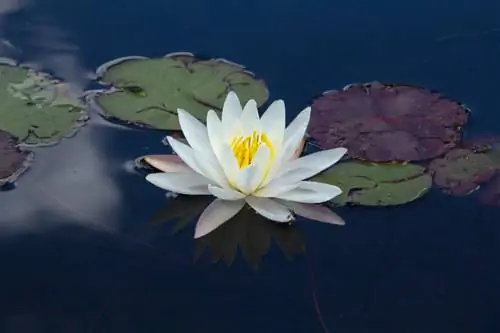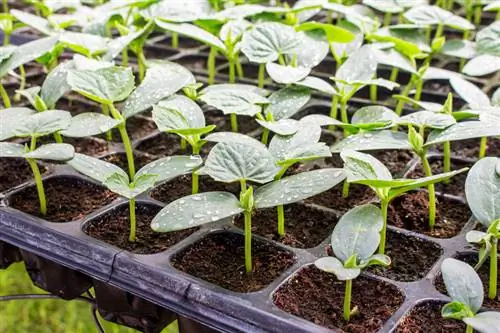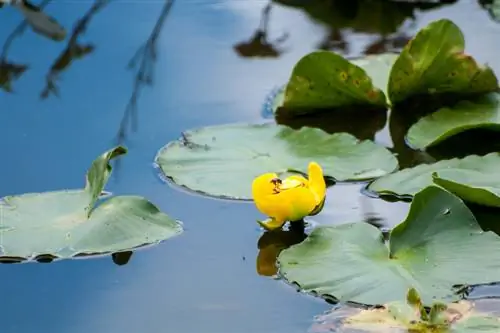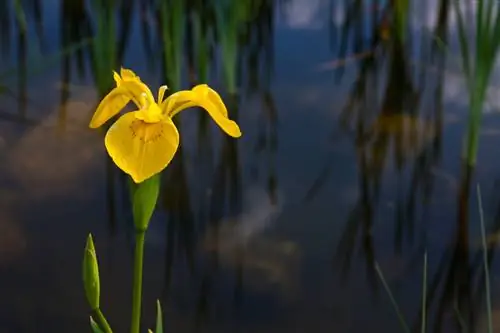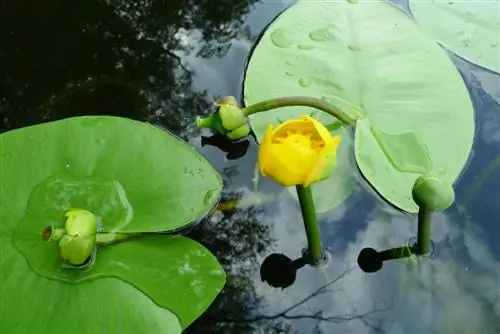- Author admin [email protected].
- Public 2023-12-25 17:45.
- Last modified 2025-01-23 11:22.
When summer is just around the corner, the majestic water lily with its yellow flowers adorns the garden pond and stream. It does not require extensive effort to successfully cultivate the iris plant. The answers to frequently asked questions presented here show how uncomplicated the yellow iris is.
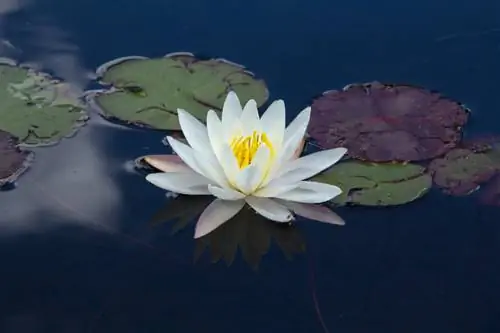
How to plant a water lily in the garden pond?
To plant a water lily successfully, place the tubers or root ball in a planting basket with ericaceous soil and fleece in 10-20 cm of water in a sunny to partially shaded location. A planting distance of 40-50 cm and regular cleaning of wilted flowers promotes he althy growth.
Planting water lilies correctly
Plant the tubers or early water lilies in the container in a sunny to partially shaded location from the end of July to the beginning/mid-October. As the perennial name suggests, the flower prefers swampy soil up to a depth of 20 cm. Since swamp irises have a reputation for being prone to overgrowth, we recommend using plant baskets (€35.00 on Amazon). This is how you can plant in no time at all:
- Make small pits at a distance of 40-50 cm and sprinkle with horn meal
- Place one rhizome at a time 5-8 cm deep in the moist soil, with the roots pointing downwards
- Place early plants in the pot so deep that the soil reaches up to the bottom two leaves
For planting in the shallow water zone, line a plant basket with fleece, fill it with ericaceous soil and insert the tuber or the potted root ball. To prevent the substrate from being washed out, mulch with small stones. Finally, the basket is sunk into the water to a maximum depth of 20 cm.
Care tips
If a water lily is in the right location, it requires little horticultural attention. Fertilizer is only given if there are deficiencies. Avoid mineral preparations as the perennial reacts harshly to them. If you clean the withered flowers regularly, this measure will contribute to a neat appearance and will extend the flowering period. After the powerful rhizome has absorbed all parts of the plant in autumn, cut the swamp iris close to the ground.
Which location is suitable?
In a sunny to partially shaded location, the water lily feels at home in humus swampy soil. It particularly likes to extend its roots in slightly acidic muddy soil, up to a water depth of 20 cm. Since the flower develops stable stems and forms dense clumps over time, the location at the water's edge can be surrounded by air. If you are struggling with constantly damp areas in the perennial bed, the yellow iris will also be happy to help, as long as an adequate water supply is guaranteed.
The correct planting distance
So that a marsh iris can develop its majestic stature, we recommend a planting distance of 40 to 50 cm from the neighbor. Arrange 3 to 4 tubers per square meter to green a large water garden with water lilies.
What soil does the plant need?
The water lily meets all expectations of its abundance of flowers when the tubers are planted in boggy, humus-rich and slightly acidic soil. The ideal water depth varies between 10 and 20 cm. It is advantageous to cultivate the swamp iris in the plant basket, as the perennial tends to overgrow. In this case, we recommend using ericaceous soil as a substrate. Where the soil in borders is too moist for classic perennials, the yellow iris acts as a problem solver.
What is the best time to plant?
If you plant the tubers in the ground between July and September, the water lily will have an excellent start to its perennial life. At this time of year the soil is wonderfully warm, allowing a root system to develop quickly. If you miss this date, use the second time slot in April/May.
When is flowering time?
The flowering period of water lilies extends from May to June. To ensure that the magnificent flowers last for many weeks, withered flowers are cleaned out regularly. Since several buds usually grow per stem, you can create space for additional specimens in this way.
Cutting water lilies correctly
Pruning plays an important role in the professional care program so that you can enjoy your water lily for many years to come. Scissors are used on these occasions:
- Cut off faded flowers regularly during the flowering period
- Cut newly bloomed stems as vase decorations
- Pruning close to the ground before the first frost
If you give a swamp iris enough opportunity to sow seeds before pruning, the perennial will take over the propagation without any further action. In this case, wait until the cylindrical fruits with the numerous seeds have opened.
Fertilize water lilies properly
Cultivated in the swamp or shallow water zone along the garden pond, a water lily is only fertilized if there are obvious signs of deficiency. Stunted flowers, dull colors or yellowed leaves indicate a lack of nutrients. In this case, administer a special liquid fertilizer for pond plants until the perennial has recovered. If the swamp iris thrives in the bed, a starter fertilization with compost and horn shavings in May is sufficient.
Wintering
The native water lily is completely hardy. In late autumn, the above-ground parts of the plant move in. The underground rhizome survives frosty temperatures down to -28 degrees Celsius undamaged. Since overwintering costs the perennial a lot of energy, it absorbs all the remaining nutrients from the leaves in autumn. Only cut off the leaves close to the ground when they have completely yellowed. If self-sowing is not desired, cut off the withered flower heads beforehand.
Propagate water lilies
To propagate a magnificent water lily, you can choose from the following two methods:
- Division of the rootstock in spring or autumn
- Sowing the seeds behind glass at 15-18 degrees Celsius, cultivated as a light and cold germinator
Please keep in mind that propagation by sowing requires a much longer patience than division. Seedling-propagated water lilies usually only bloom for the first time after 3 to 5 years.
Is water lily poisonous?
All members of the large plant family of the iris family are permeated with toxic ingredients. The highest toxin content is in the tubers. Anyone who decides to eat them will be punished with severe nausea, vomiting and other symptoms of poisoning. The water lily poses the greatest danger to pets of all kinds, as they could nibble on the bulbs, leaves and flowers.read more
Beautiful varieties
- Yellow swamp iris: The wild species impresses with its robust growth and magnificent flowers until July
- Berlin Tiger: This variety stands out with tiger fur-like petals; Growth height 60 to 100 cm
- Golden Queen: Royal water lily with golden-yellow flowers, swarmed by bees and butterflies
- Variegata: This picturesque hybrid scores with bright yellow flowers and yellow striped leaves
- Rose Queen: Rarity with delicate pink flowers over sword-shaped, smooth green foliage; Growth height 60-80 cm

